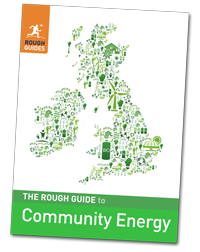 Do green electricity tariffs make much difference? And if so, which is best? This is a question I get asked quite a lot – most recently on Twitter by Francis Irving. I figured the best way to reply was to post a slightly updated extract from my book The Rough Guide to Green Living. So here goes. It’s all rather complex, so if anyone out there thinks I’ve misunderstood anything feel free to let me know in the comments. Note that I haven’t mentioned the feed-in tariffs, which kicked off since I originally wrote this, but I don’t they’d change the argument much.
Do green electricity tariffs make much difference? And if so, which is best? This is a question I get asked quite a lot – most recently on Twitter by Francis Irving. I figured the best way to reply was to post a slightly updated extract from my book The Rough Guide to Green Living. So here goes. It’s all rather complex, so if anyone out there thinks I’ve misunderstood anything feel free to let me know in the comments. Note that I haven’t mentioned the feed-in tariffs, which kicked off since I originally wrote this, but I don’t they’d change the argument much.
The big picture
A green electricity tariff is a power package that claims to offer some kind of environmental benefit. There are many such tariffs available in the UK, both from major utilities and from green specialists. Some are simple and not very ambitious: the supplier promises a token gesture such as planting a tree on behalf of each new customer. However, other tariffs offer – either explicitly or implicitly – to provide you with electricity from renewable sources. These schemes may offer some real benefits but, as we’ll see, the advertising is usually somewhat misleading.
In addition to regular green tariffs, there’s also the option of a tariff geared towards cooperative values and social justice, or a tariff that encourages you to save energy by giving discounts when you reduce your energy consumption.
‘Conventional’ green tariffs
The market for green electricity tariffs has for years been highly confusing, with some tariffs offering far less environmental benefit than the marketing material suggests. Friends of the Earth gave up ranking green tariffs in 2004 due to the complexity of working out which were and weren’t providing any real carbon savings. And a 2006 report by the National Consumer Council concluded that none of them could really claim to be offering substantial environmental benefits.
One complication comes from the fact that UK law requires all electricity providers to buy a proportion of their power from renewable sources. This rule, known as the Renewables Obligation, requires an ever-rising proportion of UK electricity to be derived from renewable sources. At the time of writing, the Renewables Obligation is currently about 11%, and rising about 1% per year. The cost of meeting – or trying to meet, as in reality we’re well behind schedule – these targets is funded by a surplus on all electricity tariffs, green and regular alike.
This grid-wide requirement is a good thing, but it leaves open the possibility that companies can sell green tariff customers the renewable energy that they were going to have to have in their portfolio anyway due to the Renewables Obligation.
Even if your supplier buys more than the legal minimum from renewable sources, that doesn’t necessarily make them more green. For each unit of renewable energy that a company generates or buys from a supplier it gets a Renewables Obligation Certificate (ROC); if it generates more than the legal requirement, it can sell the extra ROCs to other companies, which can use them in place of generating green power themselves. For this reason, the (now deceased) National Consumer Council and some other groups have argued that the only green tariffs that make a difference to the amount of renewable power being generated are those from companies that buy more than the required percentage of green electricity and then destroy (“retire”) some of the extra ROCs to help drive up their price and incentivise green generation. Some specialist power providers, such as Good Energy, have responded to these concerns by retiring a few percent of their ROCs – but the overwhelming majority still get sold. If they were all retired, the price of the tariffs would rocket, making it unlikely anyone would sign up.
Today, however, it’s more complex even than this, because the barriers to new renewable energy capacity are not so much lack of demand but planning and technical obstacles. Retiring ROCs can’t help much with those kinds of barriers – but simply ploughing ahead and driving up capacity can. In that sense green specialists like Ecotricity – which effectively combines a wind turbine installation business and an energy supply business – are doing great work. Specialists also tend to do good work behind the scenes lobbying for more ambition on renewable energy at a national level. For example, the nice folks at Good Energy seem increasingly to think of themselves as serving a think-tank role, producing papers and advice on how to rethink electricity supply in the UK to make it more amenable to increasing renewable capacity.
With all that in mind, signing up for a green specialist makes sense. On the other hand, I do think the advertising remains misleading. Most customers I’ve spoken to assume that by signing up for a green provider, their annual electricity requirements will switch from coal or gas to renewables, reducing an equivalent amount of CO2 being emitted from power stations. But that’s not really true. What’s happening is simply that much of the UK’s renewable energy capacity – driven mainly by the Renewable Obligation – is being funnelled through a few specialist green providers, who then create a green retail package around that funnel. If those providers disappeared tomorrow, that same renewable energy would simply be sold via the big energy companies instead.
This all sounds somewhat pedantic, but I think it’s important. For one thing, I’ve known more than one person over the years who has told me that they’re less worried about leaving the lights on since signing up with a green supplier because they know their power comes from wind turbines, so it doesn’t matter how much they use. Which is of course complete nonsense: the marginal impact of using more power is always to add more coal or gas to a power station somewhere, no matter what tariff you’re on, as every renewable energy device will be working flat out already. It doesn’t really matter who consumes the green power, only whether each of us are driving new capacity. Of course, the green energy companies would never tell customers not to worry about their power use, but it’s not hard to see how their adverts lead people to this way of thinking.
For another thing, green tariff marketing implicitly gives the impression that if everyone just signed up for a green tariff then we would have fixed the energy problem. In other words, it’s easy to just “do your bit” as a consumer, and job done. That’s true in the purest possible sense, but not in practice, because above a certain level, each new customer would make the tariffs more expensive, and therefore less attractive. That’s because – at the moment – the Renewable Obligation is big enough to subsidise all the green power we purchase through the green specialists. But if, say, 50% of us signed up for tariffs promising to supply us with renewable energy, the prices would have to shoot up to a level sufficient to support all that genuinely additional renewable capacity – which would make the tariffs hugely expensive.
Partly due to woolliness around the question of “additionality”, Ofgem recently launched its Green Energy Supply Certification scheme. To get the Ofgem seal of approval, the companies have to prove additionality not by supplying the customer with green power (which, as we known, is a fudge due to ROC trading) but to do something entirely separate, such as buy carbon offsets (at least one tonne of CO2 savings per customer last time I checked) or contribute towards community energy projects.
On the one hand, this seems a crazy system. You might conclude that you could just as well just stick with a regular tariff and pay £8 to a carbon offset service to soak up a tonne of CO2 in the developing world. On the other hand, at least the rules are now clearer, and in one sense switching to overseas offsetting makes perfect sense given that the UK’s power sector has capped carbon emissions anyway. (I won’t go into that debate now, but the point is that all our green electricity choices are traded away at the ETS level. What we save on electricity in the UK will be emitted instead via a power plant or glass factory in Europe. Point being that all we can really hope to achieve is to show what’s possible in the hope of tighter ETS caps going forward.)
At the time of writing, most of the big six energy providers have signed up for the guidelines for their green tariffs, along with eco specialist Good Energy. But Ecotricity (in typically bullish fashion) criticised the guidelines and decided to continue on the same path they were on before – trading ROC certificates and using the money to help support their wind turbine business.
With such a complex set of factors to surrounding the additionality question, it’s not easy to know the precise impact of the various green tariffs. Moreover, there’s the wider behaviour of the suppliers to consider. Whereas a green specialist is likely to be actively doing everything it can to expand renewables – including small-scale ones that might bypass planning delays – larger companies such as E.ON may be busily lobbying for unabated coal power stations.
This, along with the fact that you’ll be registering your concern about climate change, is perhaps the main reason to sign up for a green electricity tariff. But if you do sign up, don’t succumb to the misconception that your electricity supply will be so green that it doesn’t matter how much you use. As for whether Good Energy or Ecotricity is better – which was Francis’s question – I don’t think there’s a clear answer. From what I understand, the former is more focused on buying back power from micro-generators, and getting involved in policy work; the latter is more interested in putting up wind turbines, and also supplying biogas.
Socially equitable gas and electricity
Ebico is a nonprofit organization that focuses on social equity as well as the environment. With conventional electricity and gas suppliers, the poorest members of society end up paying the most per unit. This is because low-income customers often use expensive pre-pay meters, lack bank accounts enabling them to benefit from direct debit savings, or pay a disproportionate amount via standing charges. Ebico’s Equipower and Equigas schemes offer one price per unit, regardless of the payment method. Yet, because it’s non-profit-making, the company is able to offer competitive rates and good customer service.
For green minded customers, Ebico offers Equiclimate, whereby it purchases EU Emissions Trading Scheme carbon credits to match your total electricity and gas use and withdraws them from the market, hence forcing down the overall emissions of the power sector.
Energy saving tariffs
Southern Electric’s Better Plan tariff takes a completely different approach to environmentally friendly energy supply. The basic premise is that the greener you become, the less you’ll pay for your electricity and gas. Customers qualify for a discount of £15 when they reduce energy bills by 10% in a year. Further discounts are offered for choosing paperless billing and for improving your home’s energy efficiency: £10 for buying A-rated appliances and £20 for upgrading an old boiler or insulating your roof or walls. An energy monitor is also included with the package.
 My feature on whether the UK has reached “peak stuff” published in/on the Guardian today. Here are the links:
My feature on whether the UK has reached “peak stuff” published in/on the Guardian today. Here are the links: Do green electricity tariffs make much difference? And if so, which is best? This is a question I get asked quite a lot – most recently on Twitter by
Do green electricity tariffs make much difference? And if so, which is best? This is a question I get asked quite a lot – most recently on Twitter by  How do you engage huge numbers of people in clean energy? How do you overcome the negative press that renewables are up against? And how do create an energy-based project that’s genuinely particpatory and has broader social benefits?
How do you engage huge numbers of people in clean energy? How do you overcome the negative press that renewables are up against? And how do create an energy-based project that’s genuinely particpatory and has broader social benefits? The idea was inspired by
The idea was inspired by 
